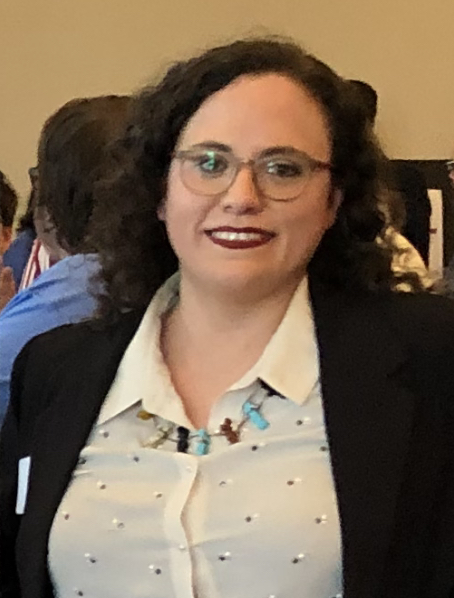Nano and Micro Technologies
(J-399) Synthesis and Characterization of Novel GBN Nanocomposites for Cancer Cell Imaging and other Biomedical Applications

Serana E. Nelson (she/her/hers)
Graduate Research Assistant
University of Oklahoma, Stephenson School of Biomedical Engineering
Norman, Oklahoma, United States
Tahrima Rouf, PhD
Visiting Assistant Professor
University of Oklahoma
Norman, Oklahoma, United States
Presenting Author(s)
Primary Investigator(s)
This research aimed to produce novel, biocompatible, nanosized hexagonal boron nitride-graphene quantum dots (GBNs) with narrow size distribution using a green approach for use in cancer imaging and diagnostics using surface enhanced Raman spectroscopy (SERS). Graphene quantum dots (GQDs) are a 0D organic material with pronounced quantum confinement and edge effects which gives them a non-zero bandgap, amphiphilicity, and good dispersibility [1]. They possess ultra-fine particle size and very large specific surface area which enables them to accommodate more active sites for functional groups, ligands, etc. [1]. Their highly tunable physicochemical properties, good chemical stability, low toxicity, stable photoluminescence, and high surface grafting make them exceptional candidates for biomedical applications [2]. Unfortunately, the predominant edges and dangling bonds present in GQDs can make their stability a challenge, revealing the need for a stabilizing compound to fully exploit their unique properties [3]. One promising material for imparting chemical stability to GQDs is hexagonal boron nitride (HBN). HBN nanosheets are a 2D, ultrathin layered material that has shown utility in biomedical applications due to remarkable properties which include self-assembly, biocompatibility, high mechanical strength, high temperature stability, and exceptional thermal conductivity [4]. The GQDs will be combined with HBN to fabricate GBNs with superior physicochemical properties for cancer cell imaging using SERS. In spite of their great potential, there are no studies to date that investigate these nanocomposites as SERS nanoparticles. This study will fill these gaps while providing a foundation for a novel approach to cancer detection using quantum-sized, biocompatible SERS nanoparticles.
Materials and Methods::
To overcome the challenges associated with GQD synthesis and their applications, a facile, low-cost, green approach for synthesizing uniform, biocompatible GQDs from organic short grain rice with narrow size distribution and tunable physicochemical properties was investigated [4]. The HBN nanosheets were purchased commercially from MSE supplies, while the GQDs were prepared through a bottom-up, green synthesis approach. The use of sustainable, environmentally friendly, and cost-effective materials was prioritized for the nanocomposite synthesis. Briefly, the rice was ground into a fine powder and heated to 200°C, sonicated and dispersed in phosphate buffer solution (PBS), dialyzed in an acidic medium, then tip filtered. Rice powder contains a large amount of starch in the form of amylose, an unbranched d-glucose chain, and amylopectin, which has glucose units linked linearly. Upon heating the rice powder, the thermal breakdown of starch leads to glucose oligomers; when the oligomers of glucose are heated to a high temperature of 200°C nucleation takes place and pyrolization of the glucose molecule leads to the growth of the GQD particle. To prepare the HBN for GBN synthesis it was sonicated in PBS to make the surface positively charged, which promoted electrostatic binding with the negatively-charged GQDs to produce GBNs. The nanocomposites were thoroughly characterized using DLS, zeta potential measurements, Raman spectroscopy, FTIR, SEM, EDS, and UV-Vis.
Results, Conclusions, and Discussions::
Characterizations confirmed the successful synthesis of the GBN nanocomposites with superior optical properties. Figure 1 depicts the results of DLS and zeta potential measurements. The GQDs had a diameter of < 6 nm with a narrow size distribution. For the HBN, a diameter between 100 nm- 200 nm was confirmed through SEM imaging and ImageJ. The diameter for the GBNs was between 150 nm- 450 nm, which is larger than the HBN diameter, suggesting that there are GQDs on the surface. Zeta potential measurements confirmed the charge reversal of the HBN induced by sonication in an ionic medium. SEM of the GBNs in Figure 2 show disc-like structures characteristic of HBN. The small black dots surrounding the HBN are GQDs. Using x-ray analysis, EDS, elemental maps with color overlays were generated. The colors associated with carbon and oxygen present on the HBN surface confirm the successful GQD conjugation. In Figure 3, UV-Vis measurements of GQDs had an absorbance peak at 190 nm and 290 nm due to the π-π* transition from sp2 aromatic domains as well as n-π* electronic transitions, respectively. The HBN sheets had an absorbance peak around 200 nm. The absorbance peak for GBNs was red-shifted to 220 nm and was more intense, indicating π-π transitions and larger size formation, which agrees with the DLS measurements. Results for FTIR can be viewed in Figure 4. The peaks indicating functional groups characteristic of both HBN and GQDs were observed in the spectra for the GBN at 3390, 1700 , 1360, and 1080 cm-1. These peaks and their associated functional groups are labeled in each figure and confirm their successful conjugation. Raman spectroscopy results are depicted in Figure 5. GQDs have a characteristic “M” shape to their spectra with two prominent peaks at 1350 and 1620 cm-1, while HBN has only one sharp peak at 1367 cm-1. The Raman spectra for the GBNs displays each of these peaks, which confirms the composition of the nanocomposite. The research presented herein was successful and provides a foundation for the development of SERS nanoparticles for advanced cancer diagnostics, drug delivery systems, and nanotherapeutics.
Acknowledgements (Optional): :
References (Optional): :
[1] A. Ghaffarkhah et al., “Synthesis, Applications, and Prospects of Graphene Quantum Dots: A Comprehensive Review,” Small, vol. 18, no. 2, p. 2102683, Jan. 2022, doi: 10.1002/smll.202102683.
[2] M. R. Younis, G. He, J. Lin, and P. Huang, “Recent Advances on Graphene Quantum Dots for Bioimaging Applications,” Front. Chem., vol. 8, p. 424, Jun. 2020, doi: 10.3389/fchem.2020.00424.
[3] D. Chen et al., “Sub-10 nm stable graphene quantum dots embedded in hexagonal boron nitride,” Nanoscale, vol. 11, no. 10, pp. 4226–4230, Mar. 2019, doi: 10.1039/C9NR00412B.
[4] J. Peng, S. Wang, P.-H. Zhang, L.-P. Jiang, J.-J. Shi, and J.-J. Zhu, “Fabrication of Graphene Quantum Dots and Hexagonal Boron Nitride Nanocomposites for Fluorescent Cell Imaging,” Journal of Biomedical Nanotechnology, vol. 9, no. 10, pp. 1679–1685, Oct. 2013, doi: 10.1166/jbn.2013.1663.
